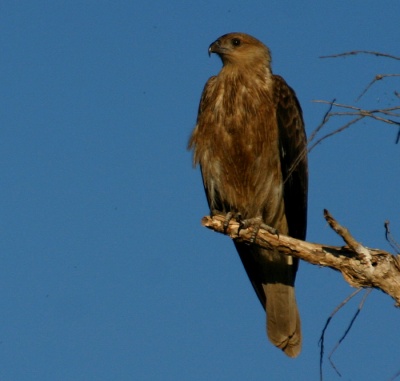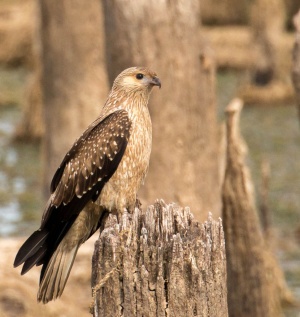m |
(Imp sizes. Clearer flight picture. References updated) |
||
| Line 2: | Line 2: | ||
;[[:Category:Haliastur|Haliastur]] sphenurus | ;[[:Category:Haliastur|Haliastur]] sphenurus | ||
==Identification== | ==Identification== | ||
| − | + | 51–59 cm (20-23¼ in)<br /> | |
*Pale buff head, breast and tail | *Pale buff head, breast and tail | ||
*Brown wings | *Brown wings | ||
*Black flight feathers | *Black flight feathers | ||
*Bone-coloured legs and feet<br /> | *Bone-coloured legs and feet<br /> | ||
| − | '''Females''' are larger and heavier than males | + | '''Females''' are larger and heavier than males<br /> |
'''Immature''' birds are a heavily-streaked rufous-brown with prominent pale wing spots | '''Immature''' birds are a heavily-streaked rufous-brown with prominent pale wing spots | ||
==Distribution== | ==Distribution== | ||
| Line 23: | Line 23: | ||
==Behaviour== | ==Behaviour== | ||
====Diet==== | ====Diet==== | ||
| − | The diet | + | The diet consists of small mammals (particularly rabbits), birds, fish, reptiles, amphibians, crustaceans, insects and carrion (especially important in the winter months). |
====Breeding==== | ====Breeding==== | ||
| − | [[Image: | + | [[Image:Whistling Kite8.JPG|thumb|350px|right|Photo by {{user|Mzungu|Mzungu}}<br />Kianawah Road, [[Queensland]], [[Australia]], May 2017]] |
The bulky platform stick nest is placed in a tall tree. It is lined with green leaves. The clutch consists of 2–3 bluish-white eggs, (may be covered with reddish-brown blotches); incubation lasts for 35–40 days. The young fledge after 44–54 days. | The bulky platform stick nest is placed in a tall tree. It is lined with green leaves. The clutch consists of 2–3 bluish-white eggs, (may be covered with reddish-brown blotches); incubation lasts for 35–40 days. The young fledge after 44–54 days. | ||
==References== | ==References== | ||
| − | #{{Ref- | + | #{{Ref-Clements6thAug16}}#Handbook of the Birds of the World Alive (retrieved May 2017) |
| + | #Wikipedia | ||
{{ref}} | {{ref}} | ||
==External Links== | ==External Links== | ||
{{GSearch|Haliastur+sphenurus}} | {{GSearch|Haliastur+sphenurus}} | ||
[[Category:Birds]][[Category:Haliastur]] | [[Category:Birds]][[Category:Haliastur]] | ||
Revision as of 22:27, 3 May 2017
- Haliastur sphenurus
Identification
51–59 cm (20-23¼ in)
- Pale buff head, breast and tail
- Brown wings
- Black flight feathers
- Bone-coloured legs and feet
Females are larger and heavier than males
Immature birds are a heavily-streaked rufous-brown with prominent pale wing spots
Distribution
Australasia: Breeds in eastern New Guinea, New Caledonia and widely distributed in Australia where it occurs virtually throughout the mainland.
Resident over most of range but nomadic in parts of Australia.
Vagrants recorded on Tasmania and King Island.
Taxonomy
This is a monotypic species[1].
Habitat
Open woodland, grassland with scattered trees, lakesides, swamps and riverine woodland.
Behaviour
Diet
The diet consists of small mammals (particularly rabbits), birds, fish, reptiles, amphibians, crustaceans, insects and carrion (especially important in the winter months).
Breeding
The bulky platform stick nest is placed in a tall tree. It is lined with green leaves. The clutch consists of 2–3 bluish-white eggs, (may be covered with reddish-brown blotches); incubation lasts for 35–40 days. The young fledge after 44–54 days.
References
- Clements, J. F., T. S. Schulenberg, M. J. Iliff, D. Roberson, T. A. Fredericks, B. L. Sullivan, and C. L. Wood. 2016. The eBird/Clements checklist of birds of the world: v2016, with updates to August 2016. Downloaded from http://www.birds.cornell.edu/clementschecklist/download/
- Handbook of the Birds of the World Alive (retrieved May 2017)
- Wikipedia
Recommended Citation
- BirdForum Opus contributors. (2024) Whistling Kite. In: BirdForum, the forum for wild birds and birding. Retrieved 1 June 2024 from https://www.birdforum.net/opus/Whistling_Kite






